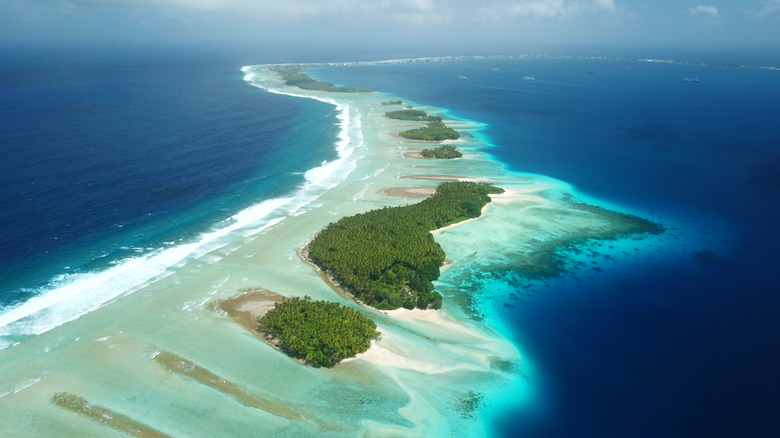The Bizarre Flight Route Between These Two Islands Technically Lands Before Taking Off
You can actually try this yourself: Go to your favorite airline-booking website, like Kayak or Google Flights. Now search for a one-way ticket from Majuro, capital of the Marshall Islands, to Honolulu, state capital of Hawaii. Try a Saturday — any Saturday. When the search results pop up, you'll see a United Airlines flight that takes about four hours and 40 minutes. The plane departs at 7:30 p.m. and lands at 2:10 a.m. All this checks out; you're passing through time zones. So, instead of arriving at 12:10 a.m., a nearly five-hour flight would probably arrive a little sooner or later, right? Nothing weird about that.
Except that you're arriving at 2:10 a.m. the same day. Your plane departs in the evening of, say, Saturday June 28, but when your plane touches down in Hawaii, you're arriving in the early morning of Saturday June 28 — 17 hours before you departed. You have, according to the clock, traveled back in time.
Time zones are already strange and confusing, especially for new travelers, so it's easy to make amateur mistakes even when planning a simple road trip. The shifting of clocks gets far more complicated when you travel from Asia to the Americas, and flights may technically land before they take off. But the flight between the Marshall Islands and Hawaii is particularly extreme, having both a relatively short passage across part of the Pacific Ocean (a 5-hour trip) and a massive change in time zones (a 22-hour difference). If you're vacationing in this part of the world and haven't taken a geography class for a while, you may wonder: Why does this happen?
Working around the International Date Line
The reason for all this confusion is the International Date Line, an invisible marker that runs down the middle of the Pacific Ocean and determines where the calendar day begins. All of this is arbitrary, of course: This "line of demarcation" was set in 1884, when Victorian-era geographers decided that the line was roughly on the opposite side of the globe from Greenwich, England — the basis of Greenwich Mean Time — and the Pacific Islands seemed sparsely populated, so putting the line there probably wouldn't bother anyone. In reality, the "day" could start anywhere, and time zones are a somewhat fuzzy concept. Even the Date Line tends to zig-zag, adjusting to the preferences of the islanders who live along it.
Still, the vast majority of humans on Earth organize their lives around the 24-hour clock, and we all passively agree that the International Date Line decides where the morning first dawns. More than 99 percent of people live on six continents, and we never have to worry about this geographic oddity in the middle of the ocean. But for the 2.3 million people living in the Pacific Islands — often known as "Oceania" — crossing the Date Line can be quite the trip. The same goes for travelers who venture to this part of the world: It's one thing to arrive in Honolulu in the middle of the night and use simple tricks to beat jet lag. It's quite another thing to gain most of a day.
Reasons to travel between the Marshall Islands and Hawaii
Pretty much everyone knows about Hawaii, and lots of us fantasize about flying into Honolulu and exploring this adventure-filled family vacation destination. But the Marshall Islands aren't nearly as well known, receiving a piddling 6,000 visitors each year. So what's the connection, aside from a temporal oddity? Why would anyone fly between their capitals?
As it happens, Hawaii and the Marshall Islands pair pretty well, if you're hoping to spend time in the middle of the Pacific. While the Marshall Islands are considered part of Micronesia and Hawaii is designated as Polynesian, the first Indigenous people came to each cluster of islands as part of overlapping maritime migrations. After thousands of years of settlement, Americans arrived on both island chains in the 19th century, and both fell under U.S. control for long periods, serving as important military bases. Their status also changed in the 20th century: Hawaii became a U.S. state in 1959, while the Marshall Islands became an independent republic in 1986. English is spoken in both places, making travel easy for U.S. tourists.
If you're looking for more than one sun-drenched paradise on the same trip, both destinations qualify. Each island chain has a tropical ecosystem, along with swaying palm trees and plenty of beaches. There's also a lot to see: In total, Hawaii has 137 islands, while the Marshall atoll has 1,225. If you're looking for an unusual place to snorkel or dive, the Marshall Islands are a great excuse to bust out that compressed air tank. If you do, just don't take that flight to Honolulu right away.


